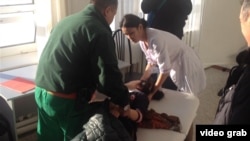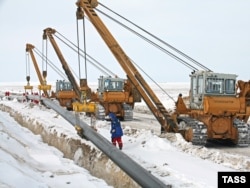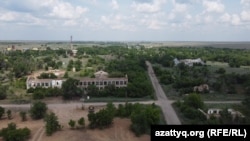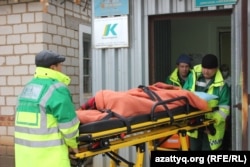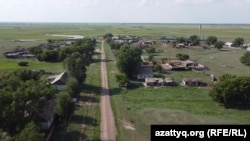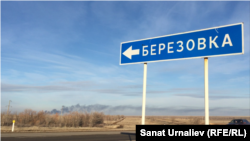This investigation is part of Caspian Cabals, a project led by the International Consortium of Investigative Journalists (ICIJ) with more than 20 media partners, including RFE/RL.
Every few months, Alina Qusmanghalieva faints. The cosmetologist once fainted in front of a client. She fell out of a chair during class when she was a college student. Another time she passed out on an airplane.
The first time it happened was a fall day a decade ago. On that morning on November 28, 2014, the 14-year-old Qusmanghalieva walked, as always, to the only school in Beryozovka (Berezovka in Russian), a village tucked into the rolling feather grass of northwestern Kazakhstan. The smell of rotten eggs hung in the air, but she was used to it; she had grown up with the stench of emissions from a nearby oil and gas field.
“For us, it was a normal phenomenon,” said Qusmanghalieva, who is now 24 years old.
After the first class of the day, she helped a student who was feeling sick to the first aid station. Then Qusmanghalieva herself began to feel ill and fainted.
By morning’s end, about 20 other kids and a handful of teachers had become dizzy, lost consciousness, and suffered seizures. Some of the students were foaming at the mouth. News quickly spread through the village as sirens blared and ambulances blew past houses, with distraught parents running through the streets shouting that schoolchildren were fainting.
The next few hours brought more frenzy. Doctors strapped the sick to stretchers and rolled them onto ambulances en route to a hospital nearly 30 kilometers away. Hundreds of adults gathered outside the school, demanding answers from local authorities but hearing nothing that made sense.
Qusmanghalieva regained consciousness that evening, lying disoriented in a hospital bed. A week later she was able to return home, but she continued fainting every day with no plausible explanations from doctors.
“We were told that, ‘You are in adolescence. Something is wrong with your head,’” Qusmanghalieva said.
In the weeks that followed, doctors and local officials at public meetings offered a slew of dubious explanations for the mysterious, synchronous illness: The parents were feeding the kids too much junk food. The girls’ periods were causing them to collapse. There was a gas leak in the school’s boiler room. The kids were faking being sick.
But the residents were confident that the children were being harmed by a massive presence in their lives that left the village smelling foul and brightly lit from gas flares even at night. They were confident that, some five kilometers away, Karachaganak, a gargantuan oil- and gas-condensate field, had released toxic emissions into their community.
In 1998, Agip (now Eni S.p.A.), British Gas Group (now Shell PLC), Texaco (now Chevron Corp.), and Russia’s LUKoil began to develop an underground reservoir containing natural gas and oil in western Kazakhstan -- the consortium was called Karachaganak Petroleum Operating (KPO).
At the time, they promised locals “paradise,” said Sergei Solyanik, an environmentalist who worked as a consultant for Crude Accountability, an American nongovernmental organization that advocates on behalf of Caspian and Black Sea communities affected by oil and gas development. Those promises included financing the construction of a gas line in Beryozovka, funding repairs of the school and the cultural center, and buying musical instruments and gifts such as backpacks for children, according to a 2010 legal appeal filed on behalf of village residents.
In addition to those projects -- some of which were more effective than others, activists say -- locals came to believe they also received something far grimmer over time.
“Poisoned land, poisoned air, poisoned water, no jobs, no good quality for local people,” Solyanik told the International Consortium of Investigative Journalists (ICIJ).
Within a few years of the reservoir’s development, agriculture and wildlife started to suffer, and residents began to experience high blood pressure, headaches, and memory loss, according to residents and activists.
These mounting environmental and health problems led to a multiyear public campaign to have the village’s residents relocated and provided with compensation. Kazakh authorities eventually announced in 2015 that Beryozovka residents would be moved and KPO would foot the bill. The relocation process took place over the following years.
Berdibek Saparbaev, who was Kazakhstan’s deputy prime minister at the time, stated during the relocation announcement that according to the Kazakh government’s assessment, the Karachaganak oil and gas field was not the cause of the health and environmental issues.
KPO said that its operations did not contribute to the health conditions of the people of Beryozovka.
“KPO’s environmental monitoring has consistently found no exceedance of harmful pollutant levels at the Karachaganak site,” a company spokesperson wrote in response to questions from ICIJ, noting that Kazakh authorities “excluded any involvement of the KPO consortium into the intoxications of children and adults in the former Berezovka village.” The spokesperson did not point to other potential causes of the mass fainting in 2014.
But problems did not just come to Beryozovka after the development of Karachaganak. People living near the Kashagan and Tengiz oil fields, more than 644 kilometers and 966 kilometers south of Beryozovka, respectively, complain of unbreathable air, oily water, and damage to their agricultural lifestyle. Oil production at Kashagan is managed by the North Caspian Operating Company (NCOC), a joint venture that includes, among others, Eni, Shell, ExxonMobil, and TotalEnergies (a French company), each of which holds a 16.8 percent interest. Tengiz’s production is managed by Tengizchevroil, which includes Chevron (50 percent) and an ExxonMobil affiliate (25 percent).
Though these joint ventures operate in different regions of Kazakhstan and go by different names, they are made up of many of the same energy giants that have profited from the country’s most valuable resources. Some of these Western companies also share an interest in a critical 1,511-kilometer Caspian pipeline that transports Kazakh oil through Russia and to European markets.
The Caspian Cabals project, led by the ICIJ and more than 20 media partners, including RFE/RL, explores the rise of the pipeline and the Kazakh oil fields that feed it. The two-year investigation is based on tens of thousands of pages of confidential e-mails, company presentations and other oil industry records, audits, court documents, regulatory filings, as well as hundreds of interviews, including with former oil company employees and insiders at Shell, Chevron, and Exxon.
But while the companies made deals with authoritarian leaders, frontline communities were left devastated or, like Beryozovka, uninhabitable.
“People lost their homeland,” Solyanik said.
ICIJ has for two years been exploring whether the Western energy companies that came to Kazakhstan left a trail of ruin, as residents believe, or if there are other plausible explanations for what has affected their health, their livestock, and their land. What is clear is that what happened here could serve as a warning for the next country the oil companies pursue in search of new resources and profits.
'We Had Everything…Then We Became No One'
Roughly the size of Western Europe, Kazakhstan is Central Asia’s wealthiest country, but the extent of its natural resources was largely unknown until 1979, when it was still part of the Soviet Union and Soviet geologists discovered two immense oil and gas fields: Karachaganak, roughly the size of Salt Lake City, and then some 966 kilometers to the south, Tengiz, more than four times the size of Paris. The country’s other giant field, Kashagan, was discovered in 2000.
When the Soviet Union fell, several parties saw opportunity in the oil and gas fields.
Kazakhstan, hoping to capitalize on its natural resources, needed modern, Western technology to develop the fields. Energy companies were eager to take advantage of these underdeveloped reservoirs. And Western governments believed there were possibilities beyond oil itself.
“Promoting Kazakhstan’s stability and independence are critical to U.S. and Western access to its energy resources,” stated a document put together ahead of then-first lady Hillary Clinton’s 1997 trip to Kazakhstan. “The Kazakhstanis, in turn, recognize that greater foreign investment and access to Western technology will be key to developing the resources that fuel economic and social growth, and promote political stability.”
Steve LeVine, a former foreign correspondent in the Soviet Union for The Wall Street Journal and the author of The Oil And The Glory: The Pursuit Of Empire And Fortune On The Caspian Sea, told ICIJ that the United States had another geopolitical motivation for encouraging foreign investment in Kazakhstan: It wanted to keep Russia in check.
“How do we ensure that Russia — now back behind its original borders and not expanded into Eastern Europe and not into its south, the Caucasus and Central Asia — how do we make sure that Russia stays there and doesn’t go back?” he said.
Largely due to foreign investment in the oil and gas sector, Kazakhstan’s gross domestic product skyrocketed in the 1990s and 2000s, figures from the World Bank show. Oil and gas are the country’s top exports and the biggest source of government revenue, according to the International Energy Agency.
That oil boom has created new jobs and corresponds with a period of economic growth and rising quality of life, especially in the larger urban centers of Almaty and Astana, as the Central Asian country climbed the United Nations Development Program’s Human Development Index to 67th place in 2024, far outpacing its neighbors and narrowly trailing Serbia and Thailand.
But the tremendous wealth generated from the oil industry hasn’t fully trickled down.
Multinational audit and consulting firm KPMG, using Credit Suisse data, reported that roughly 160 people owned half the country’s wealth in 2018.
Karachaganak is located in the backyard of Beryozovka, a village in Kazakhstan’s expansive steppe named after its many “berezy,” or birch trees. For many decades, Beryozovka was a vibrant agricultural community home to generations of Kazakh and Slavic people. It had a cultural center, a medical clinic, and a tractor-repair station; a modest grocery store, a fish-filled river, and cemeteries for both Christians and Muslims. Houses were painted bright blues and yellows to match Kazakhstan’s flag.
Locals raised cattle and horses and tended their vegetable gardens. As Soviet-era infrastructure crumbled, residents say it was an honest living though not easy: The roads were mainly dirt, there was no indoor plumbing, and the closest town was some 24 kilometers away.
“We had everything,” said Svetlana Anosova, a music teacher who lived in Beryozovka. “Then we became no one.”
In 1997, LUKoil and its Western counterparts signed a 40-year agreement with the government of Kazakhstan to develop Karachaganak under the KPO joint venture.
KPO is now operated by Shell and the Italian energy company Eni, each of which holds a nearly 30 percent stake in the company. Chevron (18 percent), LUKoil (13.5 percent) and Kazakhstan’s state oil and gas company KazMunayGas (10 percent) also hold shares in KPO.
The development of the oil and gas field brought villagers hope that the company would build up scrappy Beryozovka.
Kate Kopischke, a former dispute resolution specialist for the ombudsman’s office at the International Finance Corporation, part of the World Bank Group, said that in many developing countries, “governments don’t work for people,” so residents turn to foreign companies to provide the basic services they need.
Former librarian Damilya Mursalimova, 69, who was born and raised in Beryozovka, first lauded the infrastructural improvements, saying the company “took care of our village,” bringing gas and light to people’s homes, free of charge. Soon, though, some residents began observing alarming changes: smoke snaking into the village, the disappearance of fish from the river, vegetables quickly rotting, and animals born malformed or dying mysteriously.
Yet in a routine environmental impact assessment KPO conducted in 2002, it found no “obvious impacts by the field on flora and fauna.”
That explanation rang false to many villagers.
Vera Voskoboi and her husband lived above the river. One morning, when the 68-year-old went out to milk her cow she noticed “pink fog” floating over the water. Soon her chickens were dropping to the ground. Her cat, too, collapsed and died. She thinks her animals had inhaled hydrogen sulfide.
A KPO spokesperson told ICIJ that the company conducts regular assessments on surrounding crop, soil, and water quality and works “to minimize negative impact on the environment, to reduce environmental pollution levels, [and] to ensure protection of environment and environmental safety.”
Throughout Kazakhstan, oil and gas fields produce hydrocarbons with dangerously high concentrations of hydrogen sulfide, called “sour gas.” Inhaling hydrogen sulfide reduces oxygen flow to the brain, which may cause dizziness or more serious neurological issues. Extreme exposure can cause a person to collapse or even die.
In 2000, a Kazakh government commission found that 64 workers on the Tengiz oil field and 5 percent of residents, or 189 people, in the nearby village of Saryqamys, had died since the beginning of the field’s production. According to local media, the majority of worker deaths occurred at home and were caused by cardiovascular issues. A company executive said there was no link between those deaths and the oil field, news reports at the time stated, but environmentalists say that short- and long-term exposure to toxic fumes like hydrogen sulfide were at least partly to blame.
Back then, the late Muftah Diarov, a prominent Kazakh ecologist, wrote in an environmental magazine that 90 percent of the village population was sick. He attributed the illnesses and deaths to the “local environmental disaster” that he said was a result of the “influence of the Tengiz complex.” He signaled that other nearby communities would soon experience similar effects.
Just as people living near Tengiz worried about those risks, so, too did the citizens of Beryozovka living near Karachaganak.
“Everyone was afraid of being poisoned one day, of not getting up, not waking up,” said Mursalimova.
Anosova, the music teacher, conducted a door-to-door health survey of 400 households in 2002 and 2003. Of those she interviewed, she found that more than 75 percent of adults had experienced memory loss and the same percentage of high school students had suffered fainting spells.
“My head never stopped hurting,” said Svetlana Voskoboi, a former villager who moved to Beryozovka at the age of 24 when she married Vera Voskoboi's son. “The pain made me to want to climb up the wall and scream.”
Soon after, 110 high schoolers signed a letter appealing to the national government and the global community to address their medical concerns.
“Many of us have fainted in the last one to two years and, according to our teachers, we have become less capable during our lessons,” the letter read.
Over the next several years, KPO responded to the villagers’ growing concerns by republishing articles from regional media that stated the residents’ “concern for their health seems to be theatrical” and calling Crude Accountability, the environmental organization that advocated on behalf of residents, “altruistic.” The oil company maintained that diminished health in the community was a result of waning socioeconomic conditions in Kazakhstan after the fall of the Soviet Union, including the deterioration of Soviet-era infrastructure, like water and sewage systems.
The regional health authorities in 2004 conducted medical interviews and examinations of more than 840 residents. Doctors, local press reported, found no diseases “connected with the harmful impact of hydrogen sulfide.” The details of the report, however, were not made available to the villagers.
“They had been tested and tested by the Kazakhstani authorities, and then they never got the results,” said Kate Watters, executive director of Crude Accountability. “It was another moment where they were like, ‘Are we just guinea pigs for you?’”
A few months later, Crude Accountability organized an independent medical study, bringing 60 Beryozovites to a clinic in a nearby town to fill out a questionnaire and get blood drawn for testing. As villagers exited the clinic, unidentified men in black leather jackets tried to shove some of them into police cars.
“They were having these pushing-pulling contests,” said Watters, who witnessed the skirmishes. “The police are trying to drag women away into police cars and, when they resist, they’re physically harming them.”
In an effort to calm the chaos, Watters accompanied the men to the district government office, where she was questioned for about an hour about Crude Accountability’s work in the village. Later, a local newspaper published her passport information, saying she had violated the rules of her tourist visa.
The results of the medical study were ultimately inconclusive. Russian doctors who analyzed the villagers’ questionnaires and blood tests wrote in a report shared with ICIJ that the symptoms patients described were “characteristic of chronic exposure to irritating gases” and “directly related to production activities at Karachaganak.”
But the doctors also wrote that the sample size of residents examined had to be increased before they could make more determinations.
The community members who participated -- most of whom were children, women, or elderly -- had been frightened by the ordeal, Watters said, so they thought, “‘Let’s just keep our heads down.’”
The incident dissuaded many of them from speaking out against KPO again.
The Burden Of Proof
When KPO first took over the development of Karachaganak in 1998, part of Beryozovka was located within a government-designated, sanitary-protection zone, a nearly five-kilometer stretch deemed unsafe due to Karachaganak pollutants.
State law dictated a sanitary-protection zone of five kilometers for any field with hydrogen sulfide concentrations greater than 2 percent. Karachaganak’s concentrations ranged from 4 to 4.3 percent, according to a report by the International Finance Corporation, which invests in the private sector in developing countries. People living inside this designated danger zone were entitled to relocation that was to be carried out by the government.
KPO argued, however, that the sanitary protection zone was an outdated Soviet concept and instead used a process of reducing pollutants at their source. In KPO’s 2002 environmental-impact report, the company said Beryozovka would not be considered within the sanitary-protection zone “provided that new drilling does not occur in the territory.”
In 2003, the chief sanitary doctor of Kazakhstan confirmed that sentiment, saying that the introduction of new technology reduced threats from the natural-gas field. The doctor signed a letter allowing for the reduction of the zone in 2004 from 5 to 3.1 kilometers. (This change was suspended in 2006 and was ruled illegal and officially reversed in 2010.)
Still, Anosova and other villagers believed they should have been relocated as per the original sanitary-protection zone. Another village, Tungush, which was even closer to Karachaganak, had been relocated in 2003. This time, however, the government showed no signs of yielding.
“They never paid attention to us even though we talked and complained,” said Mursalimova, who blamed the local administration for its inaction.
It wasn’t until the mass fainting incident in 2014 that the government made a surprising statement: It would expand Karachaganak’s sanitary-protection zone to accommodate future expansion of the field, and KPO would finance the relocation of Beryozovka -- which a KPO spokesperson confirmed was paid by the company as an expense reimbursable by the Kazakh government.
This stirred up mixed emotions among the villagers. Some were glad to finally move their children away from Karachaganak, even though they felt it was too little, too late. Others were disappointed to be leaving their homes and cherished gardens.
This didn’t mean that KPO took responsibility for what was happening to the villagers.
In its 2014 annual report to shareholders, the oil consortium wrote: “there is no evidence that the emissions from KPO’s operations were the cause of the faintness which has affected the children living in the village of [Beryozovka].” In response to questions from ICIJ, KPO stated that “medical diagnosis and treatment of the citizens is the responsibility of Kazakh state authorities.” But many Beryozovites did not trust the local doctors.
“Here in Kazakhstan they simply refused to make a diagnosis,” said Svetlana Voskoboi, whose daughter became ill a few months after the mass fainting. “All the children, we were told, are pretending.”
Other parents who sought treatment for their kids at medical centers around Kazakhstan received questionable diagnoses that included neurosis, epilepsy, and diarrhea, according to Crude Accountability.
Steve Wright, then the manager of KPO’s Health and Safety Department, told villagers that there had been no excess emissions from the oil and gas field on the day of the school calamity.
Baskut Tuncak, former UN special rapporteur on toxics and human rights, said that KPO’s assurances that the natural-gas field did not cause the kids’ illnesses fell short with the villagers.
“The burden should be on the companies to demonstrate beyond the reasonable doubt that they did not cause the alleged harm,” Tuncak said. “And unfortunately, here, the burden of proof really does sit with the victims to figure out who exposed them to what for how long, and it’s an insurmountable burden; and in and of itself, having that burden is an injustice.”
Gunnar Schade, who teaches in the Department of Atmospheric Sciences at Texas A&M University, wrote in an e-mail to ICIJ that, based on the weather patterns of November 28, 2014, the day of the mass fainting, “an ongoing or new release” of hydrogen sulfide or hydrocarbons from Karachaganak may have drifted into the village, “exposing people in the lowest terrain areas, and causing the health effects observed.”
The school was located at the lowest point in the village. Schade added that Beryozovites’ symptoms over the years “were consistent with [hydrogen sulfide] and hydrocarbon exposure.”
KPO disagreed with the assessment, writing to ICIJ that “the data collected from the environmental monitoring stations located in and near [Beryozovka] show no exceedances of the relevant standards and no emissions that could be associated with the symptoms that developed.”
In 2015, three children from Beryozovka were diagnosed by doctors outside Kazakhstan with toxic encephalopathy, a brain disorder caused by exposure to toxic substances that can manifest in memory loss, lethargy, and loss of consciousness. Left untreated, the disorder can lead to permanent brain damage.
Three years later, Crude Accountability crowdfunded trips to a Moscow medical center for two of the students who had passed out that day at the school and were still severely ill. One of them was Alina Qusmangaliyeva.
“We were examined there and it was discovered that there was poisoning with a toxic substance,” she said. Qusmanghalieva and some of her classmates were prescribed yearslong treatment plans that included expensive medication and observation.
“I’m still treating my children,” Svetlana Voskoboi said. Their illness “still comes back to haunt us to this day.”
'Nobody Understands'
Since the beginning, KPO has publicized its community engagement to the irritation of many residents. In 1997, when the companies comprising KPO signed the contract to develop Karachaganak, they agreed to pay $10 million per year to the regional government for social projects. In 2010, under an agreement with the Kazakh government, KPO’s social payments doubled to $20 million per year. That money has gone toward the reconstruction of the region’s main airport, road repairs, school construction, and more. In 2021, KPO even won the government’s highest honor for corporate social responsibility.
But these types of social projects are often used for “corporate publicity, a smokescreen or ploy to build reputational value, behind which the dirty business of extraction continues business as usual,” Dinah Rajak, an anthropologist at the University of Sussex, told ICIJ.
KPO acknowledges that its role in carrying out these social projects is limited, turning to the government when residents complain. According to the company, the regional government is in charge of pulling together a list of social projects each year, and KPO is responsible for funding and managing their construction. Local contractors do the manual labor and, once the projects are completed, the government is in charge of maintaining them. That system has allowed KPO to avoid accountability for poorly executed or inconsequential projects.
In response to questions, a KPO spokesperson wrote: “KPO’s social investments are aligned with the community’s expressed needs.”
Some residents believe more attention should be focused on Karachaganak’s frontline communities rather than large investments in faraway cities, such as a $24 million concert hall in the city of Oral, roughly three hours from the oil and gas field.
This has infuriated some people who live near Kazakhstan’s oil and gas fields.
Zhanatalap, for example, is a settlement just north of Beryozovka. The community has a small network of dirt roads and it can be nearly impossible to drive out of the village on rainy days. When the roads are too muddy, Zhanatalap residents sometimes have to walk six kilometers to Karachaganak to get to their work in the field, pensioner Sergei Keldybaev said. He added that even ambulances can’t enter the village during severe rains.
When Keldybaev asked KPO employees why the company doesn’t allocate money to road repairs in Zhanatalap, they told him they provide millions of dollars each year but the money goes to the region, he said.
Kopischke, in her former role as a dispute resolution specialist for the International Finance Corporation, spoke to many companies operating in developing countries. She said some balked at the suggestion that they should provide more social and infrastructural services to local communities. But people “want something in return,” Kopischke said, “especially if you’re going to come in and have such a huge environmental and social impact.”
Elderly residents in Kazakhstan’s oil-producing regions say they’ve witnessed environmental changes since the arrival of the foreign oil companies.
In Zhanatalap, Keldybaev said his water --- which he gets from a well about 20 meters deep -- feels oily and has a metallic aftertaste. Sometimes emissions from Karachaganak trail into his village and render him, his wife, and their cattle short of breath, he said. He added that he and his wife also suffer from high blood pressure, but the local clinic prescribes them outdated medicine.
“There is no compensation, nothing,” Keldybaev said about the price locals have to pay for living near Karachaganak. “Only once a year [does KPO] provide sanatorium vouchers.”
KPO offers to send residents each year to Soviet-era medical centers. In 2022, the company reported giving vouchers to 150 people in the district that Karachaganak is in.
A company spokesperson told ICIJ that the program is “very popular with local elderly residents, but Keldybaev said he and his wife never take the company up on the offer because they can’t afford to leave their cattle. Instead, they’ve learned to live with the problems.
“Where are we going to go?” Keldybaev asked. “We don’t earn enough money to buy a house or an apartment on our pensions of 100,000 [tenge] (about $200).”
During a public hearing in March 2024, people in small towns in northwestern Kazakhstan said they’d been asking to be relocated for six years, calling the air they breathe “poisoned.”
Taskesken and Iskine are just outside the sanitary-protection zone of an oil processing facility run by NCOC -- the joint venture that includes Eni, Shell, Exxon, and TotalEnergies. NCOC, one resident said, treats locals like “guinea pigs,” adding that the construction of a railway and a gas pipeline close to the town has destroyed grazing pastures, forcing people to stop breeding animals. Other residents complained that NCOC equipment uses a lot of electricity, leaving them without enough power to run their washing machines.
In response to questions about the company’s impact on the community, NCOC wrote in an e-mail that the location of its facilities are “in line with applicable expertise and impact assessment requirements of Republic of Kazakhstan legislation.” The company stated that “no grazing pastures are located in new projects and railway station areas” and that its “production facilities are self-sufficient in electricity, heat, and steam.”
For some communities, though, pinpointing the source of their grievances isn’t always easy.
Damba, a small settlement with unpaved roads, is one of the closest to the Kashaghan offshore oil field operated by NCOC. Residents such as Erbolat Qairov, a former veterinarian who has lived there for more than half a century, have noticed the air quality deteriorate in the last several years. Damba and other towns and cities in the same region are polluted from a combination of Western-operated oil fields and state-owned refineries and evaporation ponds. But information distinguishing the effects of each of these facilities is sparse.
“We are not ecologists, not specialists,” Qairov said. “We don’t know if the emissions are above or below the limits. Our air quality is bad, but we don’t know if it comes from Kashagan, Qarabatan, Tengiz. You can’t tell the influence of the separate projects on the environment.”
Mansia Esenamanova, an ecology professor at Kazakhstan’s Atyrau University, tried to investigate the biggest sources of air pollution using an app called AirKZ, which collects data from various monitoring stations in Atyrau, the “oil capital” of Kazakhstan. She found that after NCOC monitors measured high emissions, their data stopped appearing on the app, she told ICIJ’s Dutch partner, NRC.
“NCOC is not able to switch off the online transmission from Air Quality Monitoring Stations on its own initiative,” the company told ICIJ. The AirKZ data, NCOC said, is owned by the state meteorological agency.
In June of this year, the NRC attended an NCOC public hearing held in a Damba municipal building, with paintings of fishermen and agricultural workers lining the walls. As NCOC employees discussed an offshore-drilling installation, they shared a highly technical presentation filled with complicated diagrams. For the locals, it was one more case of poor community engagement that has fostered a sense of distrust of both the oil companies and the local government.
At one point during the presentation one attendee interjected: “Nobody understands.”
Where Children Can Breathe
Vera Voskoboi, a former social worker, often visits her husband’s grave in the Beryozovka cemetery — one of the few remaining structures after KPO began bulldozing the village following the residents’ resettlement, which began in 2015. She said she looks back at her time in the village fondly. After all, it’s where she gave birth to her five children, where she planted her apple trees, where she kept horses, sheep, and geese.
Though Araltal, the small town to which Voskoboi was relocated, is near her former village, it’s a far cry from the vibrant Beryozovka she remembers. She lives on a street with dozens of identical red-brick houses built by KPO for the former villagers. Down the road is a school, also built by KPO, which has a one-room museum dedicated to Beryozovka. Black-and-white photos of the village’s earliest graduating classes are displayed along one wall, and crafts such as felt pillows with traditional Kazakh designs adorn another.
After the Beryozovites’ resettlement, Shell, one of KPO’s largest shareholders, issued a release stating that each family received a moving allowance and was compensated for property that couldn’t be moved during the relocation. It also stated that Araltal had good access to shops and hospitals.
The reality, locals said, wasn’t so rosy. “It was very difficult for us -- very difficult -- coming to a place like this,” Voskoboi said.
The roof of her new home -- made of profiled sheet -- had large gaps and water leaked from the ceiling into the kitchen when it snowed. When she was 61 years old, Voskoboi climbed onto the roof herself to patch up the holes. And after she complained to KPO about the rickety construction of the steps leading up to the house, the company sent her seven bags of cement.
Nearly halfway across the country is the main Kazakh office of Eni, one of KPO’s joint operators. The office is in one of the tallest tower complexes in Astana, the nation’s capital, famous for its glass buildings. The complex is also home to a Ritz-Carlton hotel and a shopping mall with luxury stores like Dolce & Gabbana and Tiffany & Co. As of 2023, Eni had proven reserves worth roughly $29 billion.
In 2023, Karachaganak produced more than 142 million barrels of oil equivalent, enough to meet the world’s demand for energy for half a day. The field’s production accounts for 15 percent of the Caspian pipeline’s intake.
While images of pumpjacks and oil droplets line the streets of oil-rich regions, the wealth the oil industry has generated is primarily visible in Astana. There, Nursultan Nazarbaev, the country’s first president who held the office for nearly 30 years, poured billions of dollars of public money into grand construction projects, including a mammoth mall with an indoor beach and a pyramid-shaped spiritual center. Astana has a growing middle class, but the city’s outskirts are marked by unpaved roads and ramshackle homes despite the promise of wealth stemming from Kazakhstan’s vast natural resources.
Although the United States believed -- or hoped -- that foreign investment in Kazakhstan would promote Western business practices and bolster the country’s Russia-dependent economy, researchers say that those investments helped fuel a “resource curse,” the idea that countries rich in natural resources experience slow economic growth and, often, higher rates of authoritarianism.
Maria Lobachyova, program director of the Kazakh human rights organization Echo and a board member for the Extractive Industries Transparency Initiative, said the resource curse in Kazakhstan has been manifested in the uneven growth of the country’s regions, where money generated from the oil and gas sector disproportionately benefits Kazakhstan’s cultural and economic hubs and not the people living in ecologically sensitive areas.
“It’s also because people in these centers, they have more access to social media, they are more politically active, and that’s why the head of the region maybe invests more money in these centers,” Lobachyova said. Meanwhile, “voices of the people in small districts and small towns and small villages” are rarely heard.
The country’s public finances are largely still dependent on oil profits. A 2023 World Bank report found that Astana’s state budget is “heavily reliant on oil revenue” and that “over the last 20 years, Kazakhstan's non-oil revenues have remained stagnant as a percentage of GDP.”
As KPO expands production and gas flows out of Karachaganak, some members of Beryozovka’s now-fragmented community continue to believe that their living conditions are dangerous. In Araltal, Vera Voskoboi still smells the rotten stench of hydrogen sulfide in the air and said that cancer is a common cause of death for both young and old Beryozovites.
Svetlana Voskoboi, who was relocated to the city of Aqsai, said the conditions there weren’t any better.
“We were like outcasts there,” she said. Her daughter struggled to adapt to her new school, where she continued fainting. “There were breakdowns. And the children had terrible depression.”
Eventually she sold her house and moved several hours west, far from Karachaganak. “Children breathe better here,” she said. They “live better.”
Contributors: Kobylan Aldibekov, Mariya Melnikova, Reid Standish, Mukhtar Senggirbay (RFE/RL); Carola Houtekamer, Karlijn Kuijpers (NRC); Agustin Armendariz, Naubet Bisenov, Tanya Kozyreva, Matei Rosca, Thomas Rowley, Eve Sampson (ICIJ).





